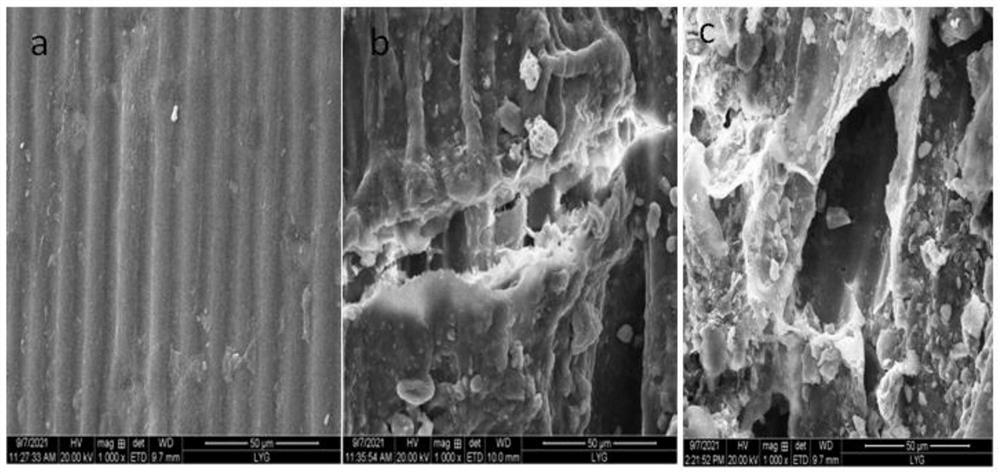Complex microbial inoculant for degrading corn straws at low temperature
A technology of compound bacterial agent and corn stalks, which is applied in the direction of bacteria, fungi, and microorganism-based methods, can solve the problem that the strains are not suitable for application under low temperature conditions in northern regions, and achieve accelerated maturity time, excellent stability, and high degradation rate effect
- Summary
- Abstract
- Description
- Claims
- Application Information
AI Technical Summary
Problems solved by technology
Method used
Image
Examples
Embodiment 1
[0032] Screening and mutagenesis of embodiment 1 Bacillus cereus
[0033] (1) Separation and screening
[0034] Collect 5g soil samples from the forest area of Changbai Mountain Nature Reserve, dissolve them in 100mL prepared saline solution, shake and culture at 10°C and 180rpm for 2-4h, the saline solution is 0.006mM FeSO 4 ·7H 2 O; 0.01 mM CaCO 3 ·7H 2 O; 0.08 mM MgSO 4 ·7H 2 O; 0.07mM MnSO 4 ·7H 2 O and 0.006mM ZnSO 4 ·7H 2 O composition.
[0035] 1mL of the mixed soil sample salt solution was subjected to different gradients (10 -2 、10 -3 、10 -4 ) dilution, take 200ul of the diluted solution and spread it on the R2a solid plate respectively, place it in a constant temperature incubator at 10°C for static culture for 7-10 days, and place it on the surface of the solid medium of the TSB plate.
[0036]TSB plate solid medium contains 0.5g yeast extract powder, 0.5g peptone, 0.5g casein hydrolyzate, 0.5g glucose, 0.5g soluble starch, 0.3g potassium dihydrogen p...
Embodiment 2
[0045] Antagonism test of each strain
[0046] In addition to the above-mentioned Bacillus cereus TK-2,
[0047] The preservation number of Bacillus subtilis used in the present invention is compiled as: CCTCC M: 2019185; the preservation number of Bacillus licheniformis is compiled as: CGMCC 1.8805; the preservation number of Bacillus megaterium is compiled as: CGMCC 1.7146; Pseudomonas berry The preservation number of Trichoderma viride is: CGMCC 3.3744; the preservation number of Aspergillus niger is: CGMCC 3.17612; the preservation number of white rot fungus is ACCC 30942; The serial number is: CGMCC5.939.
[0048] The antagonism between the various strains to be constructed by using the plate cross-hatching method and the spot method is determined, and the specific methods are as follows:
[0049] (1) Antagonism experiment between bacteria
[0050] Streak the bacteria crosswise in pairs on the LB plate, and incubate them upside down at a constant temperature of 15°C fo...
Embodiment 3
[0057] Determination of the degradation rate of each strain on straw liquid fermentation:
[0058] Weigh 5.00g of corn stalks, crush them through a 20-mesh sieve, and prepare Hutchinson medium (g / L), and inoculate 9 strains in the liquid fermentation medium according to the inoculation amount of 1% for shaking culture After 48 hours, transfer to inorganic salt culture medium, shake and culture at 15°C and 160r / min for 15 days, set 3 repeated experiments for each treatment, take the fermented product after drying and weigh it, and measure the degradation of straw by each strain Rate. Such as image 3 As shown, the degradation effect of Aspergillus niger was the best, and the degradation rate reached 40.75%, which was 15.54% higher than the slowest Pseudomonas berry. Followed by R. albicans and white rot fungus, the degradation rates were 38.77% and 38.84%.
[0059] Based on six strains of Bacillus cereus TK-2, Pseudomonas berry, Bacillus subtilis, Bacillus licheniformis, Bac...
PUM
 Login to View More
Login to View More Abstract
Description
Claims
Application Information
 Login to View More
Login to View More - R&D
- Intellectual Property
- Life Sciences
- Materials
- Tech Scout
- Unparalleled Data Quality
- Higher Quality Content
- 60% Fewer Hallucinations
Browse by: Latest US Patents, China's latest patents, Technical Efficacy Thesaurus, Application Domain, Technology Topic, Popular Technical Reports.
© 2025 PatSnap. All rights reserved.Legal|Privacy policy|Modern Slavery Act Transparency Statement|Sitemap|About US| Contact US: help@patsnap.com



